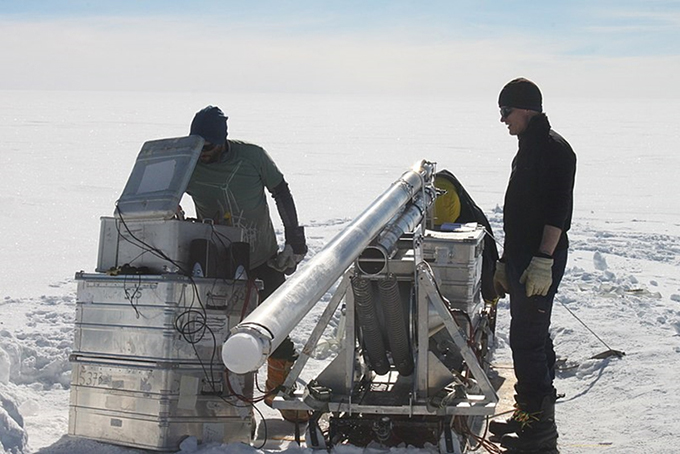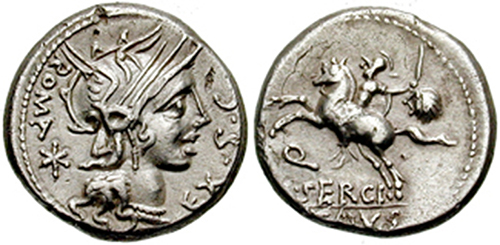
The Roman Empire had official historians—but can we trust their accounts, or were they burnishing history to please the emperors? A closer look at Roman silver has helped find the answer.
And surprisingly, this closer look came in Greenland. The ice there has recorded 130,000 years of history, as the atmospheric particles of each year are deposited in a layer of ice, one atop the other.
By drilling ice cores, then analyzing these layers with microscopes and spectrometers, we can read them like tree rings to build a detailed picture of the atmosphere over time.
This has helped today’s scientists study ancient climate, volcanic eruptions, and the success or failure of agriculture as told by pollen grains. It’s also revealed a lot about Rome.
The coin of the realm was the denarius, made of silver smelted from galena, a lead ore.
When the Roman economy was booming, smelters across the Empire pumped out silver, and spewed lead fumes into the atmosphere—which wafted across Europe to Greenland, where they settled on the ice and were preserved.
When the economy slumped, the smelters went quiet, and lead-laden emissions declined.
Researchers have now analyzed the lead levels, and they closely correspond to Rome’s official history—falling during wars and in times of plague, rising after wars and in times of peace.
Rome’s imperial storytellers largely agree with the ice cores, an admirable truth in journalism that spanned 600 years.
Background
Synopsis: Since the 1950’s, scientists have been drilling ice cores to learn about Earth’s climate; they are now finding out new details about Earth’s history. In addition to the trapped air bubbles that are studied to learn about ancient atmospheric gases, scientists have found layers of pollution and dust in cores that relate untold stories from historical periods including Rome’s glory days through its collapse, William the Conqueror’s reign, and the tragedy of the Black Plague.
- Ice cores allow us to look at a record of Earth’s atmosphere ranging as far back as 800,000 years in Antarctica and 130,000 years in Greenland.
- Ice cores are deposited as snow every year, so ages can be worked out in detail over long time frames, similar to the way tree rings are counted. Other dating techniques are also applied for corroboration.
- As snow turns to ice and is buried, it traps air bubbles, dust, pollen, sea salt, aerosols, volcanic ash, forest-fire soot, and other particulates that provide evidence about changes occurring on Earth through time.
- Samples are studied for clues in “clean room” settings using mass spectrometers, scanning electron microscopes, and gas chromatographs.
- Typical information from ice cores includes a running record of winter ice accumulation and summer ice melting rates—a direct archive of ancient pollutants and air chemistry, and isotopic evidence of temperature variations.
- Ice-core data from various locations around the globe provides consistent results on the proportions of carbon dioxide, methane, and nitrous oxide going back more than 650,000 years.
- Ice cores fill in scientific details about written historical records, helping to paint a more complete record of life. For example, the Romans left meticulous records of their empire, but was the information accurate or written according to the biases of those who ruled the land?
- One way to measure the health of a nation’s economy is by its wealth. The rise and fall of lead pollution from minting Rome’s silver denarius coins mirrored the rise and fall of the economy.

- Romans used silver coins that were smelted in clay furnaces from galena, a silver-bearing lead ore originally smelted by the Phoenicians around 1100 B.C.E.
- Smelting galena produced a lot of lead pollution, which wafted northwest for thousands of miles from Western Europe over Scotland and the Faeroe Islands, concentrating as layers in peat bogs.
- Recently, researchers used ultra-precise analysis of ice cores from Greenland to document 1900 years of European air quality from 1100 B.C.E. to 800 C.E. They found that the amount of lead in the layers of ice correlates with chronicled events from the Roman Empire.
- During the height of the Roman Empire, in the first century C.E., lead levels were six times higher than those during the height of Phoenician civilization nearly 1,000 years earlier, indicating that the economy was in full swing, with silver smelters running full tilt.
- When the Roman Antonine Plague began in 165 C.E., millions died and lead pollution dropped to pre-Roman levels and stayed there for 500 years, indicating no need for new silver coins—with so many deaths, the economy had tanked.
- Lead pollution also decreased when the Romans were at war, indicating decreased prosperity.
- Sections of two cores from a glacier in Switzerland tell us about more-recent events, from the rule of William the Conqueror in the mid–eleventh century, to the misery of multiple agricultural crises and the Black Plague in the fourteenth century, right up until the present.
- The cores were drilled into the Colle Gnifetti glacier on the Monta Rosa massif, the highest mountain in the region, located near Switzerland’s border with Italy. They were dated using water, lead, and carbon isotopes.
- Pollen, fungal spores, charcoal, and soot preserved in the top 215 ft (65 m) of the cores document increasing pastureland, industrialization, and wildfires from 1050 to 2015 C.E.
- In the Medieval Warm Period in Europe, which ranged from 950 to 1250, crops thrived in the mild climate, replacing forests and spiking grass pollen counts. Plentiful spores from a fungus that grows only on dung indicate an increase in livestock at the same time.
- The Great European Famine of 1315–1317 was caused not by drought but by too much rain, which spoiled the crops. The cores from this time show greatly diminished pollen for 5–10 years, indicating that agricultural activity slowed dramatically.
- During the Black Plague, which peaked from 1347 to 1351, over 75 million people died. Pollen preserved in the ice shows a 10-year gap, illustrating the plague’s impact on labor required for agriculture. With fewer people available to work the fields, the harvests were poor, contributing further to the tragedy. Pollen levels rebounded as villages recovered.
- Although history tells us Columbus brought maize (corn) to Europe from the New World in 1493, maize pollen isn’t found in the ice cores until the 1700’s, suggesting that regional production took a while to ramp up.
- In the 1700’s, small spherical carbon particles indicate a switch to coal-burning from wood-burning as European populations became more urban.
- In the mid–eighteenth century, the cores show complicated records of the rise of the Industrial Revolution in Europe.
- The cores also contain compressed records of the previous 9000 years in deeper 65-ft (50-m) sections that are still being studied.
- Unfortunately, these valuable records of the atmosphere and human history are melting away. As glaciers melt, water from upper layers can drip into lower layers, rendering the signals of the past useless as the particles and chemistry are mixed and degraded. It’s currently becoming more difficult to find an undisturbed glacier for research.

